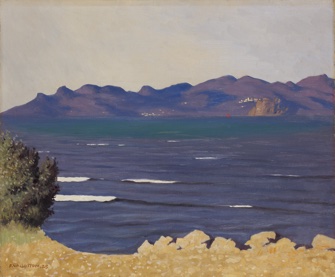
Wealth combined with good taste and an eye for the new often leads to the creation of a great art collection. That was the case with the Swiss couple Hedy Bühler and Arthur Hahnloser, who in the early 20th century put together a fine collection of post-Impressionist paintings and sculptures by artists of the day, part of which is currently on show in “Villa Flora: Les Temps Enchantés” at the Musée Marmottan Monet.
Villa Flora was the name of the couple’s home in Winterthur, where they not only hung the works of art they collected but also welcomed the artists who made them and hosted a salon where the latest trends in art were discussed and debated.
Hedy Bühler-Hahnloser seems to have been something of a frustrated artist herself, who redirected her artistic tendencies into decorating her own home and collecting art. She also published a monograph on Félix Vallotton. Her husband’s career as an ophthalmologist helped finance their interest in buying art for their own pleasure.
The exhibition consists of a series of mini-one-man (no women artists, alas, are featured) shows of contemporary artists, most of whom are now household names. While the Hahnloser-Bühlers started out by collecting Swiss artists – including Ferdinand Hodler and Giovanni Giacometti (father of Albert and Diego) – they soon moved on to artists represented by such Parisian galleries as those of Eugène Druet and Ambroise Vollard.
Among the other artists who caught their eye were Félix Vallotton (whose work had been rather neglected in recent years until it was brought back into the spotlight by a wonderful retrospective at the Grand Palais in 2013), Pierre Bonnard, Paul Cézanne, Aristide Maillol, Édouard Manet, Henri-Charles Manguin, Pierre-Albert Marquet, Henri Matisse, Odilon Redon, Pierre-Auguste Renoir, Vincent van Gogh and Édouard Vuillard.
When the couple began building their collection in 1905, Fauvism was all the rage, a fact reflected in their taste for bold color combinations and simple compositions.
The exhibition contains one beautiful work after another. Standouts for me included Hodler’s delicate “Le Cerisier” (c. 1906), the first work by the artist purchased by the couple, and his “Le Massif de la Jungfrau Vu de Mürren” (1911).
Three works by Vallotton also struck me: his moody “L’Estérel et la Baie de Cannes” (1925; pictured at the top of this page); “La Blanche et la Noire” (1913), his answer to Manet’s “Olympia,” in which the black woman appears to be the confidante rather than the servant of the naked, red-cheeked white woman stretched out on the bed; and the provocative “Le Chapeau Violet,” (1907), in which a woman in

the process of dressing (or undressing) wears a flamboyant purple feathered hat.
Among the Bonnards, I was particularly impressed by “Promenade en Mer” (1924), with its unusual perspective on three people and a dog in a sailboat at sea, and “Effet de Glace ou Le Tub” (1909). There is not much by Van Gogh, but his “Le Semeur” (1888), with its subtly colored field and lonely sower in the center is a must-see for lovers of his work. I also appreciated Manguin’s atmospheric “La Sieste ou Le Rocking-Chair, Jeanne” (1905), in which a woman in a white dress (the artist’s wife) dozes in a deck chair in the Villa Flora’s sun-dappled garden.
The exhibition also includes many photos of the couple, their home and visiting artists, but as always with this kind of show, the collection is more interesting than the collectors.
Don’t miss this lovely exhibition, which is traveling around Europe for the first time, but be prepared to wait in line to get in and to jostle for a good view of the paintings in the cramped, crowded exhibition spaces.
Favorite
